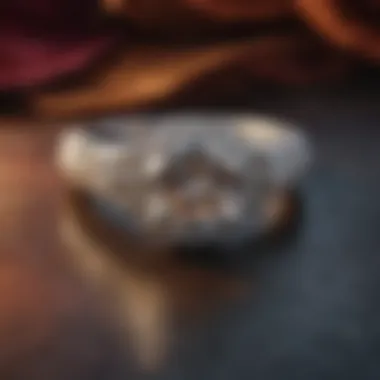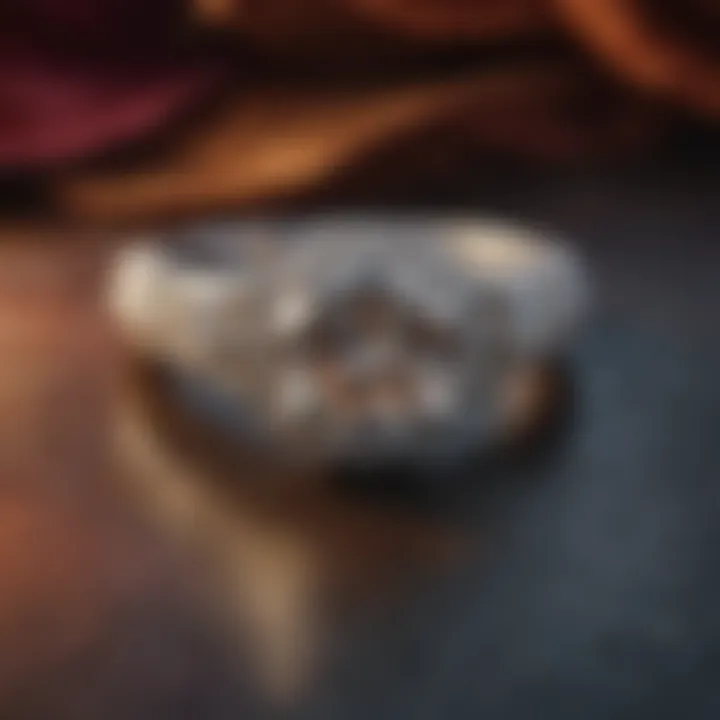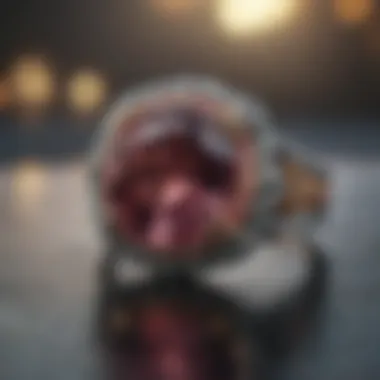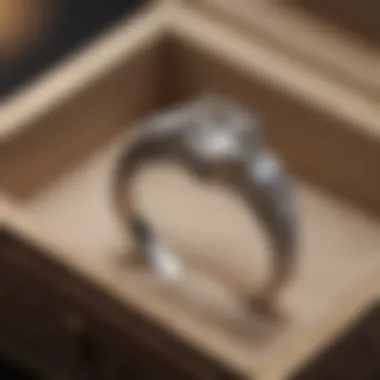Comprehensive Guide to Engagement Ring Choices


Intro
Choosing an engagement ring can feel like navigating a winding path through a dense forest. With various options looming at every turn, the journey can easily become overwhelming. A delicate balance exists between aesthetics and personal preference, and understanding each aspect is key to making a well-informed decision. This guide serves as a roadmap, illuminating the essentials of the engagement ring landscape, focusing not just on surface appeal, but also on the deeper significance behind gemstone choices and settings.
Imagine the sparkle of a diamond, the deep blue of a sapphire, or the warm glow of a morganite. Each gem tells its own story, carrying historical weight and emotional resonance that enhances its value. To truly engage with this chapter of life, one must wade through the myriad of options systematically, considering everything from gemstone types to individual taste, and even practical elements like maintenance and budgetary constraints.
Let's embark on this enlightening journey together, exploring the world of engagement rings with care and insight.
Gemstone Overview
Definition and Characteristics
Gemstones are not merely decorative items; they are nature's artistry, formed over millions of years under specific geological conditions. Each variety possesses unique traits, such as hardness, color, clarity, and brilliance. For example, diamonds, celebrated for their exceptional hardness (10 on the Mohs scale), symbolize unwavering love and commitment.
Contrasting with diamonds, sapphires are often lauded for their stunning hues, particularly the iconic blue, but also appear in various colors except red. This versatility makes them not just beautiful but adaptable, appealing to diverse tastes. Other gemstones, like emeralds and rubies, bring their own charm with distinctive colors and histories, each resonating with a specific aesthetic and emotional pull.
Classification of Gemstones
Gemstones can be broadly classified into two categories: precious and semi-precious. Traditionally, diamonds, sapphires, rubies, and emeralds fall into the precious category. These gems often command higher prices due to their rarity and desirability. In contrast, semi-precious stones, such as amethyst, garnet, and aquamarine, offer a rich range of colors and are priced more affordably.
In recent years, some semi-precious varieties have gained significant popularity, challenging the traditional boundaries. Consider the rising interest in gems like lab-created diamonds or rarer finds such as tanzanite and alexandrite. Each gemstone tells a different story and resonates with different emotions, making the choice not just a matter of taste but one that reflects personal narrative as well.
"The right gemstone does more than adorn; it embodies a promise, a sentiment that transcends time."
As you sift through the options available, take a moment to consider not just the appearance of the stone, but the feelings and stories that each gem could convey.
Historical Significance
Ancient Uses and Cultural Importance
Gemstones have been intertwined with human history for centuries. In ancient civilizations like Egypt, Greece, and Rome, gemstones were believed to hold mystical properties. The Egyptians, for instance, cherished lapis lazuli for its vibrant hue and believed it symbolized the night sky, connecting them with the divine.
Moreover, various cultures held specific gemstones sacred or associated them with powerful deities. For instance, in Hindu mythology, the ruby is regarded as the king of gemstones and is thought to bring health and good fortune. Understanding these traditions can add layers of significance to your choice, transforming it from a mere ornament to a powerful talisman.
Myths and Legends Surrounding Gemstones
Legends surrounding gemstones often enrich their appeal. For example, the myth of the opal's luckiness varies by culture; some see it as a beacon of good fortune, while others warn it to be a harbinger of misfortune.
Such myths do not just capture the imagination; they also influence purchasing decisions. An engagement ring featuring a gemstone steeped in cultural lore could resonate deeply, evoking connection with heritage or personal values.
As you reflect on what the gem you choose represents, think of how it intertwines with your own narrative and the beliefs you hold dear.
Understanding Engagement Rings
Navigating the world of engagement rings can feel like wandering through a maze. Each path leads to different styles, stones, metals, and settings. It is essential to grasp what makes an engagement ring significant not only as an accessory but also as a heartfelt symbol of commitment. The choices are plentiful, and the subtleties can make a considerable impact on the decision-making process.
When you dive into understanding engagement rings, you open up a dialogue about love, history, and personal expression. Rings are not mere pieces of jewelry; they carry weighty emotional significance. Choosing a ring involves considering the wearer’s personality, style, and values. Are they traditional or contemporary? Do they prefer classic designs or bold statements? Answering these questions will guide you through the selection process.
One can't overlook the financial aspect either. Engagement rings can range from modest to extravagant in price. It's wise to define a budget early on. This clarity can prevent any stress later, ensuring that the ring you choose is both meaningful and manageable financially. So, as you embark on this journey, keep a balance between aesthetic desire and practical considerations.
Moreover, as we explore engagement rings, we cannot ignore the diverse materials available. From diamonds to sapphires, each gemstone tells its own story, and understanding their qualities can enhance your purchasing decision.
In summary, understanding engagement rings is not just about picking out a ring; it’s about weaving together emotion, tradition, and personal style into one cohesive choice. By appreciating what goes into an engagement ring, you'd be equipped to make a decision that resonates deeply for both you and your partner.
The Significance of Engagement Rings
The significance of an engagement ring is deeply rooted in culture and personal meaning. It represents a promise, a commitment to a shared future. The act of presenting a ring often signifies the intention to marry. In many cultures, the ring itself becomes a spotlight of the relationship, admired by friends and family alike at significant life events, such as engagements, weddings, and anniversaries.
There are many facets to this significance:
- A symbol of love and commitment.
- A reflection of individual style and personality.
- A tangible reminder of a significant life moment.
The ring often serves as a conversation starter among couples and potential family members, bridging connections over shared stories and aspirations. The significance extends far beyond the jewelry shop; it evolves as the couple's journey progresses over the years.
Historical Overview of Engagement Rings
From ancient times to present day, engagement rings have held a unique place in society. Historically, these rings have morphed in design, material, and significance.
In ancient Rome, an engagement ring was crafted from iron, symbolizing strength and durability. Fast forward to the Renaissance period, gold and gemstones became the norm, indicating wealth and status. Interestingly, the practice of using diamonds on engagement rings only gained popularity in the 19th century after the successful marketing strategies of diamond mining companies.
Key historical highlights include:
- Roman Era: Iron rings were common.
- Renaissance: Introduction of gold and gems.
- Victorian Era: Ornate designs with intricate details became fashionable.
- 20th Century: Marketing by diamond companies popularized diamond engagement rings.
The emergence of modern styles is also worth noting. As society has progressed, so too has the variety of styles. Artistic movements reflected in rings, such as Art Deco and Minimalism, have laid the groundwork for current trends.
In essence, the historical trajectory of engagement rings offers insights into how they have been perceived and cherished across cultures and eras. This knowledge enriches the process of selecting a ring today, grounding the experience in a broader narrative.
Gemstone Options for Engagement Rings
When it comes to selecting the perfect engagement ring, the choice of gemstone looms large. Each gemstone carries its own narrative and essence, making it a pivotal decision in the quest for a symbol of commitment. Beyond just aesthetic appeal, gemstones can reflect personal stories, cultural values, and even ethical convictions. Thus, making an informed choice about gemstone options creates a more meaningful relationship with the jewelry.
Diamond Engagement Rings
Diamonds have long been synonymous with engagement rings. Their allure stems from a combination of durability and brilliance that is hard to match. Whether they sparkle brightly under candlelight or glimmer in sunlight, diamonds are often seen as the quintessential choice.
Color and Clarity


Color and clarity are both crucial facets when discussing diamonds. Color refers to the absence or presence of color in the diamond, typically graded on a scale from D (colorless) to Z (light yellow). A diamond with a higher grade is generally more sought after due to its brilliance and the way it refracts light. Clarity, on the other hand, looks at the internal imperfections or inclusions within the diamond. A flawless diamond provides a certain purity and aesthetic appeal, even though naturally occurring imperfections can sometimes add distinct character to the stone.
For many, the clarity and lack of color might create a desirable allure, but it is essential to remember that these qualities can also drive up costs, making high-quality diamonds an investment.
Cut and Carat Weight
The cut of a diamond can greatly influence how it reflects and disperses light, thus affecting its overall beauty. The term "cut" goes beyond the shape; it encompasses how well the diamond has been shaped and polished. The better the cut, the more scintillation and brilliance the stone has. Carat weight, however, is a measure of how heavy the diamond is. While larger stones are usually more expensive, considerations of cut can sometimes render a smaller diamond just as captivating.
Choosing a well-cut, smaller diamond can offer the same wow factor as a larger, poorly cut one, hence it’s crucial to weigh the significance of both attributes when making a selection.
Ethical Considerations
In recent years, the conversation around ethical diamonds has gained traction. Potential buyers today often prioritize conflict-free stones, those sourced without causing social conflicts or environmental destruction. The rise of lab-created diamonds is another avenue that many consider. These diamonds possess the same physical and chemical properties as natural diamonds but come at a lower cost and with less ethical ambiguity.
While traditional diamonds may be more revered for their natural origin, the increasing availability of ethically sourced stones offers a way to assert both commitment and personal values in one’s choice of jewelry.
Alternative Gemstone Choices
Many are opting for gemstones beyond diamonds, bringing a burst of color and excitement into engagement rings. Such choices reflect individuality and personal style, often making the rings stand out in a sea of traditional options.
Sapphires
Sapphires are not just blue; they come in a kaleidoscope of colors. The deep blue shade often associated with sapphires symbolizes loyalty and integrity. Their durability stands second only to diamonds, making them an excellent choice for everyday wear. With the resurgence of colored gemstones in engagement rings, sapphires also allow for more personalization in design and can often be more affordable compared to similarly-sized diamonds.
Emeralds
Emeralds, with their vibrant green hues, resonate with life and renewal. They are softer than both diamonds and sapphires, which means they require a little extra care to maintain their beauty. The charm of emeralds lies in their distinct color and internal inclusions, often known as 'jardin'. This unique appearance can elevate their attractiveness, though vigilance in care is necessary to keep them looking pristine.
Moissanites
Moissanites are gaining popularity as a diamond alternative. They possess similar brilliance but are generally more affordable. Another attractive feature of moissanites is their ethical standing, as they are typically lab-created, ruling out the social implications tied to diamond mining. For couples wanting a striking appearance without a hefty price tag, moissanites are a compelling option.
Rubies
Rubies are cherished for their deep red color and symbolize passion and love. With a hardness similar to sapphires, rubies are also quite durable, making them tight contenders for engagement rings. The vibrant hue can evoke strong emotional connections and their rarity makes them particularly special. However, quality rubies can be costly, leading to careful consideration when choosing.
Personalized Gemstone Selections
Creating a personal touch can often overshadow diamond-centric traditions, leading couples to seek unique characteristics in their engagement rings. Personalized gemstone selections offer a creative take on engagement rings.
Birthstones
Incorporating birthstones adds a personal connection to the ring, often signifying important dates or events in one’s life. Each stone holds unique meaning and symbolism, enriching the ring's narrative. While some may appreciate the significance of the stone, considerations regarding durability and wearability come into play. Selecting the right birthstone based on its hardness and suitability for daily wear can make or break the ring’s longevity.
Custom-Designed Rings
A truly distinctive option lies in custom-designed rings. Here, couples can choose everything from gemstone selection to band style. Custom designs create not just rings but artifacts of individual love stories. While this path allows for incredible creativity, it often requires additional time and budget considerations, but the end result is a piece of jewelry that resonates on a deeply personal level.
Overall, the landscape of engagement ring options is rich and varied, allowing couples to express their distinct stories and values through the gemstones they choose.
Setting Styles and Designs
The style and design of the setting can make or break an engagement ring. It's like dressing the gemstone in its Sunday best; the right setting elevates the entire piece, showcasing the stone in every possible light. Different settings can dramatically influence both the aesthetic and practical aspects of an engagement ring, including the overall feel, durability, and how the ring interacts with daily life. From classic styles that never go out of fashion to modern designs that speak to today’s aesthetics, exploring these options gives one a solid grounding before making that final choice.
Classic Settings
Solitaire
The solitaire engagement ring is arguably the most iconic setting out there. This design features a single diamond or gemstone, usually set atop a sleek band. What makes the solitaire stand out is its simplicity, allowing the central stone to truly sparkle and shine. The beauty is in its unembellished elegance; there are no distractions, just the sheer brilliance of the gem in focus.
- Key Characteristic: Minimalist design emphasizing one grand stone.
- Benefits: Classic appeal, easy to match with wedding bands, and versatile for various settings.
- Disadvantages: Less secure for stones, as they can be more prone to snagging and can scratch more easily on that delicate prong setting.
In essence, a solitaire ring beautifully captures the essence of commitment while boasting straightforward elegance.
Three-Stone
Three-stone rings hold profound symbolism, representing the past, present, and future shared by a couple. Each stone in this setting is often of similar size, creating a cohesive look that can be incredibly eye-catching. It’s a design that’s perfect for those who appreciate a touch of story with their jewelry.
- Key Characteristic: Three gems aligned together, often in a row.
- Benefits: Allows for personalization with different stones or styles, can be set with different types of gemstones matching the wearer’s personality.
- Disadvantages: Depending on the design, it can appear cluttered if not well balanced, or may stretch the budget depending on the quality of the stones.
This design can lead to deep conversations about the shared history within a relationship, enriching the meaning behind the ring itself.
Bezel
The bezel setting envelops the gem fully in metal, securing it in a way that feels wonderfully substantial and secure. This setting is becoming increasingly popular, especially among active individuals who want to avoid the risk of losing their stone.
- Key Characteristic: Metal encases the stone fully or partially, providing security.
- Benefits: High durability and safety for the stone, smooth profile that reduces snagging.
- Disadvantages: Less light exposure to the stone compared to other settings, which can reduce sparkle.
With its balance of safety and sleek design, the bezel is an excellent choice for those looking for a practical yet stylish option.
Modern and Vintage Settings
Art Deco
Art Deco settings harken back to the 1920s and 30s, adding a unique flair to engagement rings. Characterized by geometric shapes and intricate detailing, these settings have a vintage charm that captures the eye.
- Key Characteristic: Bold geometric designs often featuring contrasting colors and intricate metalwork.
- Benefits: Distinctive look that is often a conversation starter and can stand out in contemporary settings.
- Disadvantages: Can be harder to find, may require more upkeep as intricate settings can collect dirt or be more vulnerable to damage.


Choosing Art Deco lets couples express their individuality while inviting a touch of history into their lives.
Minimalist
In today’s fast-paced world, minimalist settings resonate with many. This design eschews extravagance for sleek lines and understated elegance, focusing on the quality of the gem itself rather than embellishments.
- Key Characteristic: Simple bands with a focus on clean lines and less clutter.
- Benefits: Timeless beauty that effortlessly blends with any outfit or style, making it versatile for everyday wear.
- Disadvantages: Some may find the lack of embellishment too plain for their tastes.
Minimalist rings create a sense of peace and clarity, perfect for those who prioritize simplicity and refinement in their lives.
Engraved Designs
Engraving adds a personal touch to engagement rings, where names, dates, or even meaningful quotes can be inscribed on the band. This extra detailing enriches the ring's significance, turning it into a truly one-of-a-kind piece.
- Key Characteristic: Text or designs engraved onto the inside or outside of the band.
- Benefits: Personal touch that allows wearers to carry special memories and messages.
- Disadvantages: Might wear over time or become less visible, especially if not cared for properly.
Engraved designs allow couples to carry a piece of their love story, memorably intertwining their experiences with each glance at the ring.
Choosing the Right Metal
Selecting the right metal for an engagement ring cannot be overstated; it's not just a matter of taste but also an interplay of durability, skin sensitivity, and budget considerations. Each metal option brings its own unique properties to the table, influencing the overall aesthetic and longevity of the ring. The metal acts as a foundation for the gemstone, and its selection can greatly impact how a stone’s beauty is showcased. Therefore, understanding the characteristics of the various metals is crucial for making an informed choice that will last a lifetime.
Popular Metal Choices
Platinum
Platinum is a metal that carries a reputation for its unparalleled purity and durability. When one thinks of luxury and lasting power, platinum often jumps to the forefront. This metal is hypoallergenic, making it a top pick for those with sensitive skin. Its natural white sheen enhances the brilliance of any gemstone, allowing for a stunning visual appeal. Unlike gold, platinum doesn't wear away; instead, it develops a soft patina over time, which many find charming. However, it does come with a higher price tag, and while it resists tarnishing, scratches are still a possibility.
White Gold
White gold has become a favorite for many couples looking to combine elegance with affordability. It's essentially yellow gold mixed with other metals like palladium or silver, and then finished with rhodium plating for that shiny, white appearance. This plating can wear off over time and may need reapplication, but it’s less expensive than platinum and offers a similar aesthetic. White gold also complements diamonds and other gemstones exquisitely, allowing their colors to pop. Just keep in mind, some people may have allergic reactions if they're sensitive to the metals in the alloy.
Yellow Gold
Yellow gold has an everlasting appeal that resonates with many. Its warm glow symbolizes traditional romance, making it a cherished choice for many couples. Made from a mix of pure gold and other metals such as copper and silver, yellow gold is particularly suited for intricate designs and vintage-inspired styles. It does require a bit of maintenance as it can scratch or dent and may tarnish if not cared for properly. For those who appreciate a classic look, yellow gold stands the test of time, both in trends and in wear.
Rose Gold
In recent years, rose gold has gained immense popularity, injecting a vintage charm into modern aesthetics. This metal blends gold with copper, giving it a unique rosy hue that softens its appearance. It's versatile, pairing beautifully with different types of gemstones, especially softer tones like morganite or diamond. Rose gold is also generally more durable than yellow gold due to its copper content. However, its unique rose-like charm might not appeal to everyone, and it could require more upkeep to maintain its rose-like sheen as the copper can tarnish over time.
Durability and Maintenance Considerations
When acquiring an engagement ring, understanding the durability of the chosen metal is as crucial as the appearance. Durability affects how often one must undertake maintenance, which is especially important for something intended to be worn daily. While platinum is undeniably tough and largely scratch-resistant, white gold often requires additional care to maintain that pristine coat of rhodium.
"A ring is not merely an accessory; it's a lifelong promise entwined with your personal storytelling. Choosing the right metal ensures that this narrative endures with beauty and resilience."
Therefore, it's wise to consider not only the initial selection of metal but also how that choice aligns with your lifestyle and care preferences. For instance, those who frequently engage in manual work may opt for the robustness of platinum or make sure to marry style with comfort by selecting a more durable option like yellow gold or rose gold, which allows for a more relaxed yet elegant style.
Balancing aesthetics, durability, and maintenance will certainly guide you to the perfect metal choice, ensuring your engagement ring stands as a robust symbol of love and commitment.
Budgeting for an Engagement Ring
When it comes to engagement rings, budgeting is a crucial step that can influence not just your choice of ring, but also your peace of mind in making such an important purchase. A clear budget prevents overspending and guarantees that the ring you pick aligns with your financial situation and expectations. After all, while an engagement ring is a symbol of commitment, it should also fit comfortably within the realm of what you can truly afford without straining your finances.
Setting a Realistic Budget
Establishing a realistic budget is about more than just tossing a number out there. It requires some soul-searching and practical considerations. A good starting point is to think about your financial health and your partner’s preferences. Consider the following points:
- Income and Expenses: Look at your current financial obligations. How much can you realistically set aside for an engagement ring without compromising your day-to-day living expenses?
- Expectations: What styles and gemstones have you or your partner discussed? Getting an idea of what’s desired helps you allocate funds effectively. The costs can vary significantly based on factors like stone type and setting style.
- Future Goals: Think about any immediate future expenses, like a wedding or a down payment for a home. You don’t want to stretch your budget for a ring only to feel the pinch later.
Ultimately, the goal should be to define a budget that is both practical and aligned with your situation. The clearer the picture, the better the choice you can make. In fact, according to many jewelers, a budget that is sensible can often lead to surprising and beautiful ring options that still fulfill the symbolism of love and commitment.
Exploring Financing Options
If the perfect ring stretches beyond your immediate budget, financing options can act as a bridge. Many jewelers offer various financing plans which make the process of purchasing an engagement ring more manageable. Here are some financing options to consider:
- Store Financing Plans: Some jewelers provide in-house financing that can offer low or even zero percent interest for a predetermined period, making monthly payments more feasible.
- Personal Loans: If you’re comfortable taking on debt, a personal loan can be a good option, provided the interest rates are favorable.
- Credit Cards: Using a credit card for this purchase is another option, though be mindful of the interest rates and your ability to pay it off as soon as possible to avoid accruing high costs.
- Layaway Plans: Some jewelers allow customers to make payments towards the ring before taking it home. This can alleviate the burden of one large payment when the ring is finally purchased.
Ultimately, your choice of financing should not only fulfill the need to purchase the ring, but also fit into your long-term financial plans. Utilizing smart options will keep your financial health in check while still allowing you to express your commitment.
In summary, understanding how to budget for an engagement ring is not a mere step in the process; it's an integral part of ensuring the symbol of your love is just right in every way.
The Importance of Ring Size
Choosing an engagement ring isn't solely about the shimmer of the gemstone or the intricacies of the setting. One of the pivotal aspects that often gets overshadowed is the fit—the size of the ring. Having the right ring size ensures comfort and security. A ring that’s too loose may slip off, leading to a lost symbol of commitment, while one that’s too tight can become uncomfortable and might risk damage to both the ring and the wearer’s finger.
The size of the ring also adds an essential layer to the emotional weight of the purchase. A perfectly sized ring feels like it was made just for that person, enhancing the sentimental value. It transcends mere adornment; it becomes a personal expression of love.
Measuring for the Perfect Fit
Getting the right measurement isn't rocket science, but it’s not just a casual guess either. There are several methods to measure for the perfect fit:
- The String Method: Use a piece of string or a soft piece of paper. Wrap it around your finger, take note of where it overlaps, and measure the length with a ruler. Careful though, measure when your fingers are at a normal temperature; cold or hot fingers can distort the measurement.
- Use a Ring Sizer: These can often be found at jewelry stores. A professional will provide you with a set of plastic rings or a measuring tool for accurate sizing. This can be the most trusted way to ensure the right fit.
- Existing Rings: If the intended recipient already wears rings, use one they own that fits well. Measure the inside diameter and compare it to a ring size chart to find the corresponding size.
"Even the most beautiful gem means little if it doesn't fit right"
Keep in mind, factors such as time of day, weather, and temperature can affect finger size. As a rule of thumb, it's best to measure in the evening when fingers are slightly larger due to natural swelling.


Considerations for Resizing
Life changes and so do our fingers. It’s not uncommon for a ring to require resizing—either up or down. When considering resizing, here are a few key points to keep in mind:
- Material Matters: Different metals have varying properties. For example, platinum can be easier to resize than some gold alloys which may crack more easily during the process.
- Design Complexity: Intricate settings with multiple stones may complicate resizing. It could potentially loosen or damage the stones if not handled carefully.
- Seeking Professional Help: Getting the ring resized is not a DIY project. Always seek a professional jeweler who can handle the task correctly without compromising the ring’s integrity.
Resizing isn't just about adjusting the size; it can also be an opportunity to refresh the ring. A resizing can be paired with cleaning, making it feel rejuvenated.
Ensuring a proper fit when selecting an engagement ring is not just practical; it’s also symbolic of the thoughtfulness that goes into the choice. A well-fitted ring represents the harmony between the couple, a continuous circle of love that should feel just as perfect as it looks.
Caring for Your Engagement Ring
When one embarks on the journey of selecting an engagement ring, the excitement is palpable. However, the adventure doesn't end at the moment of purchase. Caring for your engagement ring is paramount. Not only is it a symbol of love and commitment, but it also represents a significant investment, often holding emotional and monetary value. Neglecting its care can lead to unflattering wear and tear, which diminishes its charm and beauty over time. Therefore, having a practice for maintenance and cleaning can enhance its longevity, helping it sparkle for years to come.
Cleaning and Maintenance Tips
Keeping your engagement ring clean is both straightforward and necessary. A dirty ring can lose its luster, making even the finest diamond look dull. Here are some tips to ensure your ring remains in tip-top shape:
- Regular Cleaning: Ideally, clean your ring once a week. Soak it in a mix of warm water and a few drops of mild dish soap for about 20-30 minutes. Use a soft toothbrush to gently scrub edges and settings where dirt can accumulate.
- Avoiding Harsh Chemicals: Many household cleaners, especially those containing bleach, can tarnish or damage certain metals and stones. Stick to gentle soaps for safe and effective cleaning.
- Drying Methods: After cleaning, gently pat your ring dry with a soft, lint-free cloth. Avoid abrasive towels, as these can scratch the metal or stone.
- Storage Considerations: When you’re not wearing your ring, store it in a soft pouch or the original box to prevent scratches or tangling with other jewelry.
When to Seek Professional Help
Even with diligent care, there will be times when professional intervention is necessary. Here are some scenarios where expert help is advisable:
- Loss of Stones: If you notice any stones are loose or missing, it's crucial to consult a jeweler immediately. Catching this early can prevent permanent loss.
- Metal Wear: Rings can become scratched or worn over time, especially if worn daily. A jeweler can polish and refurbish your ring to restore its original shine.
- Periodic Check-ups: Just like any other valuable, having a professional inspection every few years is a good practice. Jewelers can check the settings and overall condition to ensure your ring remains secure and dazzling.
"An engagement ring is not just a piece of jewelry; it's a commitment. Look after it, and it will look after you!"
Navigating Ethical Considerations
When it comes to the journey of selecting an engagement ring, ethical considerations are gaining increasing attention. It's no longer just about picking the prettiest rock or the trendiest design. Nowadays, more and more couples are becoming aware of the moral implications behind their choices in gemstones and metals. This section illuminates the importance of maintaining an ethical compass during your search for the perfect engagement ring. By diving into the realms of conflict-free stones and sustainable sourcing practices, we aim to equip readers with knowledge that transcends aesthetics and taps into conscious consumerism.
Understanding Conflict-Free Stones
Conflict-free stones are those that are sourced without funding violence, human rights abuses, or environmental degradation. A prime example is the Kimberly Process, which was established to ensure that diamonds are obtained from regions that are not afflicted by conflict. This framework, though not without its criticisms, marks a significant move towards ethical sourcing.
Choosing conflict-free stones not only supports responsible mining operations but also promotes better living conditions for miners and their communities. This choice resonates well with consumers looking to make a meaningful statement about their values. Here's a breakdown of what to consider when looking for conflict-free options:
- Certification: Look for independent certification that guarantees stones are conflict-free.
- Transparency: Select retailers who provide detailed information about their sourcing practices.
- Reputation: Research the brand’s history regarding ethical sourcing.
"The diamond industry is evolving; it's vital for consumers to align their choices with their values."
In making these informed decisions, couples not only invest in a piece of jewelry but also in a legacy of ethical consumerism.
Sustainable Sourcing Practices
Sustainable sourcing practices extend beyond conflict-free stones and delve into the broader environmental and social aspects of gemstone procurement. It encompasses a range of practices that aim to mitigate environmental impact and promote social equity within mining communities.
Here are notable practices to keep in mind:
- Responsible Mining: Beyond being conflict-free, this emphasizes minimal environmental disruption and the treatment of mining workers fairly.
- Recycling and Upcycling: Utilizing previously-owned or vintage materials not only reduces waste but also lessens the demand for newly mined gemstones and metals. This can give a unique story behind each ring.
- Artisanal Mining: Supporting small-scale or artisanal operations can often lead to a more equitable distribution of wealth within mining communities.
- Eco-Friendly Materials: Some jewelers are taking the leap into eco-friendly materials, minimizing the carbon footprint associated with creating jewelry.
Incorporating these practices in your engagement ring selection makes for a choice that reflects not just love, but also respect towards the earth and its people. As customers demand more from brands, the industry is starting to respond, but it starts with informed consumers who are ready to make ethical choices.
Trends in Engagement Rings
When it comes to selecting an engagement ring, understanding the current trends can significantly enhance the decision-making process. These trends not only reflect personal taste but also showcase broader cultural shifts, allowing couples to express their individuality and commitment in a way that resonates with modern values. From increasingly popular gemstone choices to innovative designs that blend tradition with contemporary aesthetics, being mindful of these trends can lead to a more satisfying selection.
Emerging Styles in Popular Culture
Fashion and media play a crucial role in shaping our preferences when it comes to engagement rings. For instance, recent years have witnessed a surge in styles inspired by celebrities and influencers. Couples often turn to social media platforms like Instagram and Pinterest to seek ideas, and many are adopting looks that symbolize their unique journeys.
- Vintage Designs: Vintage rings, especially those reflecting the elegance of the Art Deco period, have made a notable comeback. Intricate filigree and unique silhouettes evoke a sense of nostalgia and individual history, offering a charm that new designs sometimes lack.
- Colorful Gemstones: Gone are the days when diamonds ruled supreme for engagement rings. Sapphires, emeralds, and even colored diamonds are now seen as bold choices. This shift not only allows for personal expression but also offers alternatives for those looking to break from tradition.
- Nature-Inspired Elements: Many engagement rings are adopting motifs and designs inspired by nature, such as floral patterns or organic shapes. This trend reflects a deeper appreciation for environmental beauty, resonating particularly with couples who prioritize sustainability.
"Choosing an engagement ring isn't just about the gem; it's about telling a story that matters to you."
The Rise of Customization
In a world where mass production is becoming the norm, customization presents an appealing alternative, especially in the realm of engagement rings. More couples are choosing to design a ring that truly embodies their relationship. This trend speaks to a growing desire for individuality and personal meaning in what is often one of the most significant purchases of their lives.
- Personal Touches: Custom rings allow for personal touches—be it engraving a significant date or selecting a unique gemstone that has personal meaning. This can create a deeper emotional connection to the ring.
- Collaboration with Jewelers: Engaging with jewelers to co-create a ring can enhance the experience. This often involves discussing options for various elements, such as the type of metal, setting style, and gemstones. Collaborating closely can result in a piece that feels uniquely theirs.
- Cultural and Familial Influences: Couples might choose to incorporate elements from their cultural backgrounds or family heirlooms, weaving stories and traditions into their engagement ring. This not only adds a sense of history to the ring but also strengthens the couple’s connection to their roots.
Navigating these trends means more than just following popular culture; it reflects deeper values in today’s society. Couples are gravitating towards what rings symbolize for them, emphasizing personalization and authenticity, which is what makes these trends significant in the world of engagement rings.
Ending
When it comes to choosing an engagement ring, the conclusion of this exploration emphasizes more than just selection; it underscores the essence of understanding and a personal journey. Throughout the article, we have examined an array of topics that not only make up the framework of engagement rings but also encapsulate the emotions behind them. Making informed choices rests heavily on the myriad of considerations presented, ranging from gemstone preferences and ring settings to budgeting and care considerations.
Recap of Key Considerations
In summary, several key elements guide the journey of selecting an engagement ring:
- Gemstone Selection: The choice between traditional diamonds or alternative stones, like sapphires or moissanites, dramatically alters the aesthetic and meaning of the ring. Understanding each gem's properties helps in making a choice that resonates personally.
- Setting Styles: The design plays a pivotal role in how the gemstone is showcased. Understanding the differences between classic settings like solitaire and contemporary styles can lead to a choice that reflects the individual's taste and relationship.
- Metal Choices: Different metals bring their own charm and context to engagement rings. Factors like durability, maintenance, and personal style strongly influence the selection of metals such as platinum, white gold, or rose gold.
- Budgeting Essentials: Establishing a realistic budget ensures that the search is fruitful without being financially burdensome. Exploring financing options can ease the stress that often accompanies this major purchase.
- Ring Size and Care: Ensuring a proper fit is essential for comfort and longevity. Knowledge on routine care and knowing when to seek professional help preserves the ring’s brilliance.
Final Thoughts on Choosing an Engagement Ring
Selecting an engagement ring is a significant milestone in a relationship. This choice is not just about the material; it weaves together hopes, dreams, and memories. Each ring bears a story, a token of commitment that is as unique as the individuals wearing them. Whether one opts for a grand statement piece or a simpler design, the ring should embody the couple's journey.
Ultimately, take time to weigh each consideration. Allow space for meaningful conversations about acceptability and expectations. Whether one is inclined towards classic elegance or modern flair, the right engagement ring should always resonate with personal and shared values.
Choosing wisely ensures that the ring will not just serve as a piece of jewelry but become a cherished heirloom, filled with love and memories for generations to come.
"An engagement ring is more than just a piece of jewelry; it’s a promise etched in time."
As couples look to express their love, the knowledge gleaned from this guide arms them with the insights they need, ensuring they select a ring that’s not just beautiful but deeply representative of their commitment.







